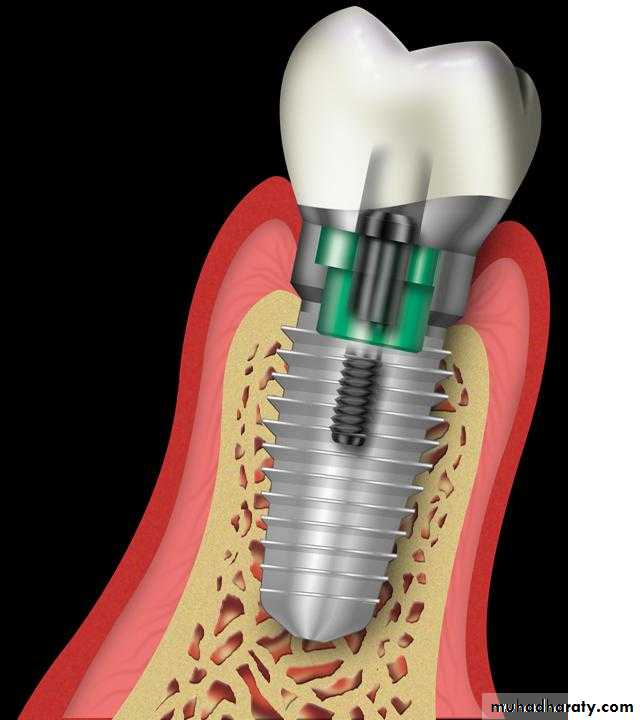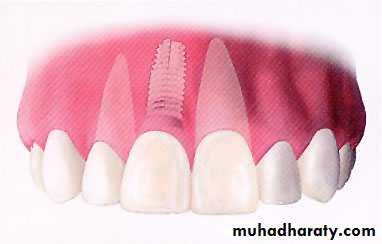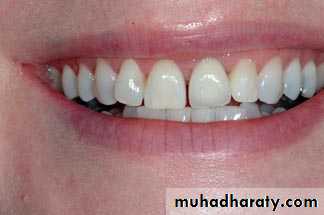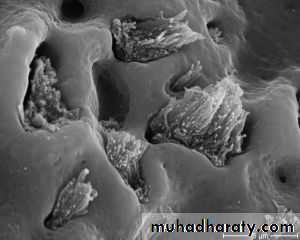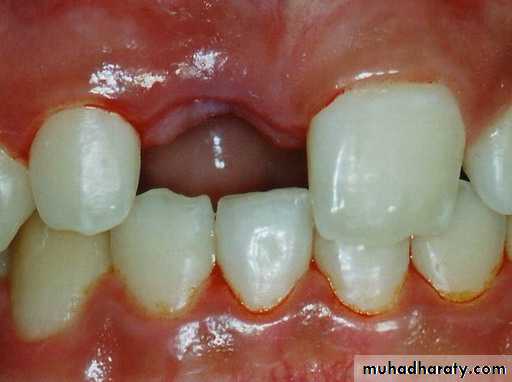Dental implants
Dental implants are titanium screws that are surgically inserted to be permanently anchored to the jaw.
Dental implant is an artificial alloplastic material placed surgically into the jaw to support a dental prosthesis.
The titanium has been selected due to the following proven characteristic:
1- strength.2- light weight.
3- biocompatibility.
4- history of success in the field of medical joints replacement.
Anatomy or parts of the dental implant
1- the crown: a replacement tooth, custom made to match the color of adjacent teeth.2- abutment : a devise that support and connect the crown to the implant fixture.
3- fixture : is a titanium device imbedded in the jaw bone to replace the original root of the tooth.
Dr,salah hegazy
Dental implantsIndications for dental implants.
• Intolerance to removable dental prosthesis.• Need for long span fixed prosthesis with questionable prognosis.
• Single tooth loss that will make it necessary to prepare sound adjacent teeth for a fixed prosthesis.
• Unfavourable condition, location and number of abutment teeth.
Contraindications for dental implants.
1- the mandible is atrophic as there is a high risk of fracture.2- there is an alveolar bone deficiency and the patient declines bone grafting.
3- The patient is emotionally and psychologically unstable (eg, bruxism, poor home care).
4- underlying disease or disorders of the bone are present ( eg, osteoporosis)
5- the patient is a smoker.
• 6- In the case of patients subject to radiant therapy, wait for at least one year from the interruption of the radiant therapy before proceeding with the implant treatment.
• 7- chronic alcoholism are absolute contraindications
Dr,salah hegazy
Advantages & disadvantages of implant over conventional treatment
Advantages: 1- Implants do not involve preparation of the adjacent teeth,2- they preserve the residual bone, and 3- excellent aesthetics can be achieved.
Disadvantage: 1- it is expensive,2- the patient requires surgery, 3- time consuming, and 4- technically complex.
Advantages of dental implants
• Preservation of tooth structure.• Fixed bridge Implant
Eliminates the need to grind healthy teeth necessary to produce conventional bridge work.
Cont …
• Fixed partial dentures• Single tooth implants
• Significant reduction in the amount of tooth structure is necessary
• long term survival:
• 87% at 10 yrs, 69% at 15 yrs
• Less expensive
• no need for preparation of adjacent teeth.
• Long term survival:
• 96.5% at 11 yrs
• More expensive
Advantages of dental implants
• Preservation of bone: reduce bone loss and gum recession associated with missing teeth• loss of teeth →
• Lack of stimulation to the residual bone →
• Decrease in bone density, height and width.
Bone resorption after extraction
Bone resorption in edentulous patientsMost of the bone loss occurs in the first year after extraction) 2mm per a year).
Continued bone loss for more than twenty years 0.2 mm per a year.
Four fold greater in mandible than in maxilla.
Upwards and medially in maxilla, downwards and laterally in mandible.
• Teeth stimulate bone → maintain bone.
• Implants stimulate bone → maintain bone.
• Complete and partial dentures don’t stimulate bone →
• Bone resorption, acceleration of bone resorption if ill fitting →
• Decreases the surface area available for prosthesis support.
• Eliminates favourable anatomy for retention.
• Results in unfavourable denture bearing areas.
Always inform your patient of the anatomical consequences of tooth loss.
Always inform your patient of the preventive nature of dental implants.Advantages of dental implants
• Provision of additional support .it assist in proper chewing allowing for a healthy and improved deit.• Dentate patient can exert up to 1000 psi of bite force.
• Edentulous patient ( complete denture wearers) can only exert up to 50 psi of bite force.
• Transitioning a patient from complete denture to an implant supported prosthesis will result in a dramatic increase in bite force.
Advantages of dental implants
• Retrievability , replacement and salvaging of the restoration.Advantages of dental implants
• Resistance to disease.
• Implants are resistant to caries, natural teeth are not.
Consider extraction of teeth and place implants if :
The patient has poor manual dexterity, and hence can’t maintain good oral hygiene.The patient has Xerostomia due to medications (root surface caries).
Advantages of dental implants
• Increased confidence.• 7- Improved aesthetics, function and speech.
•
Confidence
• Dental implants have become the standard of care for the replacement of teeth.• They allow your mouth to be restored to optimum function and appearance without invading or damaging other teeth or tissue.
Advantage of Dental Implants
8- Increase chewing ability and improve bite force
9- Decrease denture mobility : ensure a secure and comfortable fitting denture.
Use of removable prosthesis will not allow patient to recover normal function, aesthetics, speech and comfort.
Implant supported prosthesis allow patient to function with confidence and enjoy better quality of life.
osseointegration
A direct structural and functional connection between living alveolar bone and the load carrying surface of the dental implant .An osseointegrated implant takes anywhere from three to six months to anchor and heal, at which point the dentist can complete the procedure with the placement of a crown. Once the implant has anchored with the jawbone, artificial prosthesis may be attached . If osseointegration does not occur, the implant will fail ( fibrous integration).
Biology of
Osseointegration1.Osteophyllic phase: fibrocartligenous callus formation ( 1 month ).
2.Osteoconductive phase: Spongy callus ( 3 month )
3.Osteoadaptive phase: Cortical bone
( steady state )
migration of osteoblasts & osteoid production to the implant surface
Last of approximately 1 month.
Osteophylic Phase
the bone cells spread along the implant surface laying down osteoid and takes about 3 months
Osteoconductive Phase
جمعــية الحفــــاظ على صـــحة الفــــم والأسنـــــان العـــراقيــــة – مــــركـــــز زراعــــة الاسنــــانa steady state ( no gain or loss of bone against metal) resorption remodeling sequence that continues even after the implants are exposed and loaded
Osteoadaptive phase
جمعــية الحفــــاظ على صـــحة الفــــم والأسنـــــان العـــراقيــــة – مــــركـــــز زراعــــة الاسنــــان
Dr,salah hegazy
Factors affecting osseointegration• Implant biocompatibility
• Implant design
• Implant surface area
• Implant bed ( type of bone),
• Surgical technique.
• Loading condition
Why O I Failed
جمعــية الحفــــاظ على صـــحة الفــــم والأسنـــــان العـــراقيــــة – مــــركـــــز زراعــــة الاسنــــان
Primary stability
Primary stability is the initial mechanical lock between the screw implant and the bone , it depend on :1- the length of the implant .
2- the diameter of the implant .
3- the thread design: number and thickness of the grooves.
4- the quality of the bone site : cortical versus spongy bone .
5- the preparation of the surgical site, heat generation, torque, and speed of the handpiece.
Secondary stability
When the inflammation subsided and the Osseo integration takes place . usually after 3-6 months.Dr,salah hegazy
• Immediate occlusal loading (placed within 48 hours postsurgery)• 2- Early loading (prosthetic function within two months)


